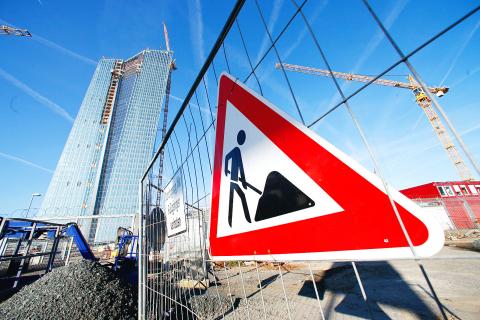On top of high unemployment and sluggish growth, the European Central Bank (ECB) has a new headache: an unexpected drop in inflation.
Most people think lower inflation is good news because it makes things easier to buy — and usually it is. However, the current slide is just another sign of how weak the economic recovery is in the 17 countries that use the euro.
An official report this week showed a surprise drop in the inflation rate to 0.7 percent in September from 1.1 percent the month before. That is well below the ECB’s stated goal of close to but below 2 percent that it considers ideal for the economy.

Photo: Bloomberg
However, the monetary authority for the eurozone may be running short of tools to deal with the problem.
The drop in inflation shows demand is weak: People are not able or willing to risk spending or borrowing. Sellers cannot raise prices as much.
That remains the case in the eurozone, where unemployment is at a record of 12.2 percent and the economy only just emerged from a long recession with anemic growth of 0.3 percent in the second quarter. The worst outcome would be outright deflation. That is an economic death spiral, when a chronic fall in prices leads people to hold off spending because they know goods will become cheaper. Europe is still some distance from that.
Much of the downdraft comes from countries having the most trouble from the debt crisis. In Portugal, Ireland and Spain, inflation has been lower than the eurozone average — and prices even fell 1 percent in hardest-hit Greece in September. Wages fell in those countries, too. Labor cost increases have slowed in the eurozone as a whole, to an annual 0.9 percent in the second quarter.
The ECB has already used up most of its traditional medicine: lower interest rates. Its benchmark rate — what it charges to loan to banks — is at 0.5 percent, the lowest since the euro was introduced in 1999.
Yet a top ECB council member, Luc Coene of Belgium, has said an unexpected drop in inflation would demand a response.
A few analysts say the ECB might trim the benchmark rate again next week. Howard Archer, an analyst at IHS Global Insight, said the inflation figure had “moved the goal posts” and that a cut was “very much on the agenda.”
Besides trimming its benchmark refinancing rate, the ECB could bring its deposit rate — what it pays banks on money they keep with the ECB — below its current level of zero.
That would in theory push banks to stop stashing money at the ECB, but it could also backfire. Banks might simply pass on the cost to customers in the form of higher interest rates. And a negative rate could hurt bank profits at a time when regulators are trying to strengthen banks’ finances.

WEAKER ACTIVITY: The sharpest deterioration was seen in the electronics and optical components sector, with the production index falling 13.2 points to 44.5 Taiwan’s manufacturing sector last month contracted for a second consecutive month, with the purchasing managers’ index (PMI) slipping to 48, reflecting ongoing caution over trade uncertainties, the Chung-Hua Institution for Economic Research (CIER, 中華經濟研究院) said yesterday. The decline reflects growing caution among companies amid uncertainty surrounding US tariffs, semiconductor duties and automotive import levies, and it is also likely linked to fading front-loading activity, CIER president Lien Hsien-ming (連賢明) said. “Some clients have started shifting orders to Southeast Asian countries where tariff regimes are already clear,” Lien told a news conference. Firms across the supply chain are also lowering stock levels to mitigate

IN THE AIR: While most companies said they were committed to North American operations, some added that production and costs would depend on the outcome of a US trade probe Leading local contract electronics makers Wistron Corp (緯創), Quanta Computer Inc (廣達), Inventec Corp (英業達) and Compal Electronics Inc (仁寶) are to maintain their North American expansion plans, despite Washington’s 20 percent tariff on Taiwanese goods. Wistron said it has long maintained a presence in the US, while distributing production across Taiwan, North America, Southeast Asia and Europe. The company is in talks with customers to align capacity with their site preferences, a company official told the Taipei Times by telephone on Friday. The company is still in talks with clients over who would bear the tariff costs, with the outcome pending further

Six Taiwanese companies, including contract chipmaker Taiwan Semiconductor Manufacturing Co (TSMC, 台積電), made the 2025 Fortune Global 500 list of the world’s largest firms by revenue. In a report published by New York-based Fortune magazine on Tuesday, Hon Hai Precision Industry Co (鴻海精密), also known as Foxconn Technology Group (富士康科技集團), ranked highest among Taiwanese firms, placing 28th with revenue of US$213.69 billion. Up 60 spots from last year, TSMC rose to No. 126 with US$90.16 billion in revenue, followed by Quanta Computer Inc (廣達) at 348th, Pegatron Corp (和碩) at 461st, CPC Corp, Taiwan (台灣中油) at 494th and Wistron Corp (緯創) at

NEGOTIATIONS: Semiconductors play an outsized role in Taiwan’s industrial and economic development and are a major driver of the Taiwan-US trade imbalance With US President Donald Trump threatening to impose tariffs on semiconductors, Taiwan is expected to face a significant challenge, as information and communications technology (ICT) products account for more than 70 percent of its exports to the US, Chung-Hua Institution for Economic Research (CIER, 中華經濟研究院) president Lien Hsien-ming (連賢明) said on Friday. Compared with other countries, semiconductors play a disproportionately large role in Taiwan’s industrial and economic development, Lien said. As the sixth-largest contributor to the US trade deficit, Taiwan recorded a US$73.9 billion trade surplus with the US last year — up from US$47.8 billion in 2023 — driven by strong